We included HMH Into Math Grade 8 Answer Key PDF Module 10 Lesson 3 Order Real Numbers to make students experts in learning maths.
HMH Into Math Grade 8 Module 10 Lesson 3 Answer Key Order Real Numbers
I Can accurately order a list of real numbers containing fractions, decimals, and irrational numbers.
Step It Out
All real numbers correspond to a position on a number line. Real numbers include rational and irrational numbers.
Question 1.
Estimate \(\sqrt {50}\) to the nearest tenth.

A. Find the two perfect squares closest to 50, one greater than 50 and one less than 50.
__________ and ___________
Answer:
49 and 64,
Explanation:
Perfect squares closest to 50, one greater than 50 is 64 as 8 x 8 = 64, perfect squares closest to 50,
one less than 50 is 49 as 7 x 7 = 49.
B. What are the square roots of the two perfect squares?
___________ and ___________
Answer:
7 and 8,
Explanation:
Perfect squares closest to 50 are 8 x 8 = 64, 7 x 7 = 49, So 7 and 8.
C. The whole number that most closely estimates \(\sqrt {50}\) is _____________.
Answer:
Most closely estimates \(\sqrt {50}\) is 7,
Explanation:
As the square root of 50 is 7.07106 so most closely estimate is 7.
D. Refine your estimate of \(\sqrt {50}\). Circle the true statement. Then underline the value closer to 50.
7.02 < 50 < 7.12
7.12 < 50 < 7.22
7.22 < 50 < 7.32
7.32 < 50 < 7.42
7.42 < 50 < 7.52
7.52 < 50 < 7.62
Answer:
7.02 < 50 < 7.12,
Explanation:

Question 3.
Estimate \(\sqrt[3]{100}\) to the nearest hundredth.
A. Find the two perfect cubes closest to 100, one greater than 100 and one less than 100.
____________ and ____________
Answer:
125 and 64,
Explanation:
The perfect cube closest to 100, one greater than 100 is 5 x 5 x 5 = 125,
the two perfect cubes closest to 100 and one less than 100 is 4 x 4 x 4 = 64.
B. What are the cube roots of the two perfect cubes?
____________ and _____________
Answer:
4 and 5,
Explanation:
A perfect cube of a number is a number that is equal to the number, multiplied by itself, three times.
If x is a perfect cube of y, then x = y3. Therefore, if we take the cube root of a perfect cube, we get a natural number and not a fraction. Hence, 3√x = y. So 4 and 5.
C. Circle the pair of cubes \(\sqrt[3]{100}\) lies between.
4.53
4.63
4.73
4.83
4.93
5.03
Answer:
4.63 and 4.73,
Explanation:
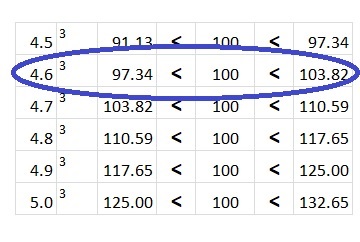
D. Within your interval, test cubes of values expressed in hundredths. Which cube is closest to 100? “Approximately equal to” is represented by the ≈ symbol.
__________ is closest to 100, so \(\sqrt[3]{100}\) ≈ ___________.
Answer:
4.63 is closest to 100, so \(\sqrt[3]{100}\) ≈ 97.34,
Turn and Talk What is your strategy for estimating a square root or a cube root to the nearest hundredth?
Answer:
Using perfect square for square roots and perfect cubes for cube roots,
Explanation:
Strategy for estimating a square root or a cube root to the nearest hundredth are
Step 1: Identify a smaller number closest to the given number that is a perfect square.
Step 2: Subtract the two numbers from step 1 and step 2.
Step 3: Substitute the values from step 1 and step 2 in the following formula and solve.
Then approximate the answer to the nearest hundredths.
Question 3.
You can use estimates of square roots to help you estimate and compare numerical expressions involving square roots.
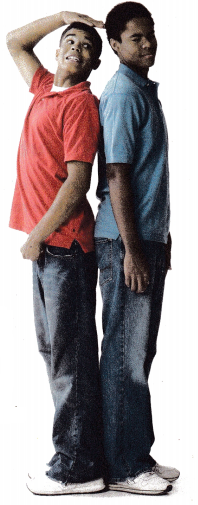
A. Compare the values below. Write < or > to complete each statement.
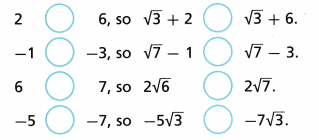
Answer:
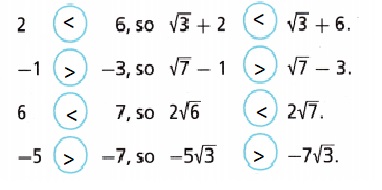
Explanation:
Given to compare the values so Value of root 3, √3 =1.732, Value of root 4, √4 = 2,
Value of root 5, √5 = 2.2360, Value of root 6, √6 =2.449, Value of root 7, √7 =2.645,
Value of root 8, √8 =2.828, √3+2 = 1.732+2 = 3.732, √3+6 = 1.732+6 = 6.732,
so 2 < 3 and √3+2 < √3+6, -1 > -3 and √7 -1 > √7 – 3, 6 < 7 and 2√6 <2√7,
-5 > -7 and -5√3 > -7√3.
B. Complete the statement with consecutive integers.
8 is between the perfect squares ___________ and _____________, so the value of IŠ is between the integers __________ and _________.
Use this information to complete the inequality with integer values.
___________ < \(\sqrt {8}\) + 3 < ____________
Answer:
8 is between the perfect squares 2 and 3,
so the value of IŠ is between the integers 4 and 9,
Explanation:
Completed the statement with consecutive integers as 8 is between the perfect squares 2 and 3,
so the value of IŠ is between the integers 4 and 9.
C. Compare the values below. Write < or > to complete each statement.

Complete the statement with consecutive integers.
5 is between the perfect squares _________ and ___________,
so the value of \(\sqrt {5}\) is between the consecutive integers ____________ and __________.
Use this information to complete the inequality with integer values.
___________ < 3\(\sqrt {5}\) < ____________
Answer:

Explanation:
5 is between the perfect squares 2 and 3, so the value of \(\sqrt {5}\) is between
the consecutive integers 2 and 3.
Use this information to complete the inequality with integer values.
6 < 3\(\sqrt {5}\) < 7, 6 < 6.708 < 7
D. Complete the inequalities using consecutive integers.
____________ < \(\sqrt {13}\) – 1 < _____________
____________ < \(\sqrt[3]{40}\) + 1 < _____________
____________ < \(\sqrt[3]{25}\) + 2 < _____________
____________ < \(\sqrt {111}\) – 4 < _____________
____________ < \(\sqrt {109}\) – 1 < _____________
____________ < \(\sqrt {30}\) + 5 < _____________
Answer:
2 < \(\sqrt {13}\) – 1 < 3, 4 < \(\sqrt[3]{40}\) + 1 < 5, 4 < \(\sqrt[3]{25}\) + 2 < 5, 6 < \(\sqrt {111}\) – 4 < 7, 3 < \(\sqrt {109}\) – 1 < 4,
7 < \(\sqrt {30}\) + 5 < 9,
Explanation:
Completed the inequalities using consecutive integer as above.
Turn and Talk Explain the strategy you used to complete Part D.
Answer:
The strategy is first identify all the square root values and add or subtract the values given in the inequalities equation to the inequalities using consecutive integers.
Explanation:
Consecutive integers are those numbers that follow each other.
They follow in a sequence or in order.
Question 4.
A. Identify the integers between which each number is located.
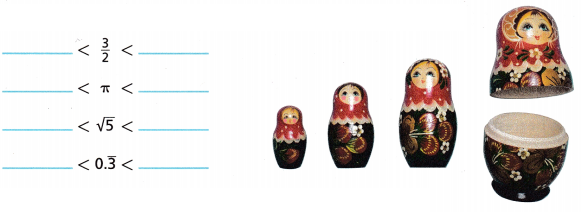
Use the comparisons to plot and label the points on the number line.

Answer:

Explanation:
\(\frac{3}{2}\) = 1.5, \(\frac{22}{7}\) = 3.14 , \(\sqrt {5}\) = 2.236
0.3, comparison 0.3 < \(\frac{3}{2}\) < \(\sqrt {5}\) < \(\frac{22}{7}\)
0.3 < 1.5 < 2.236 < 3.14,
B. Identify the consecutive integers between which each number is located.
___________ < –\(\sqrt {12}\) < ____________
___________ < -4.75 < ______________
___________ < \(\sqrt {x}\) – 8 < ___________
___________ < –\(\frac{17}{3}\) < _____________
Use the comparisons to plot and label the points on the number line.

Answer:

Explanation:
___________ < –\(\sqrt {12}\) < ____________
\(\sqrt {12}\) = 3.46, -4 < -3.46 < -3, ___________ < -4.75 < ______________
-5 < -4.75 < -4, ___________ < \(\sqrt {x}\) – 8 < ___________, x is variable, the value if x = 0 , – 8
___________ < –\(\frac{17}{3}\) < _____________, 17/3 = 5.66, – 17/3 = – 5.66.
Check Understanding
For Problems 1-3, use < or > to compare the expressions.
Question 1.
\(\sqrt {6}\) ![]() \(\sqrt {7}\)
\(\sqrt {7}\)
Answer:
\(\sqrt {6}\) ![]() \(\sqrt {7}\),
\(\sqrt {7}\),
Explanation:
As 2.44 ![]() 2.64 so \(\sqrt {6}\)
2.64 so \(\sqrt {6}\)![]() \(\sqrt {7}\).
\(\sqrt {7}\).
Question 2.
\(\sqrt {10}\) ![]() \(\sqrt[3]{25}\)
\(\sqrt[3]{25}\)
Answer:
\(\sqrt {10}\) ![]() \(\sqrt[3]{25}\),
\(\sqrt[3]{25}\),
Explanation:
As 3.162 ![]() 2.924 so \(\sqrt {10}\)
2.924 so \(\sqrt {10}\) ![]() \(\sqrt[3]{25}\).
\(\sqrt[3]{25}\).
Question 3.
\(\sqrt {5}\) + 4 ![]() \(\sqrt {50}\) + 1
\(\sqrt {50}\) + 1
Answer:
\(\sqrt {5}\) + 4 ![]() \(\sqrt {50}\) + 1,
\(\sqrt {50}\) + 1,
Explanation:
As 2.23 + 4 ![]() 7.07 + 1 so
7.07 + 1 so
\(\sqrt {5}\) + 4 ![]() \(\sqrt {50}\) + 1
\(\sqrt {50}\) + 1
Use the information to solve Problems 4-5.
Marc and Amber are producing a design for a side table. They want the top of the table to have a length of \(\sqrt {7}\) feet and the side of the table to have a length of \(\sqrt {3}\) feet. Estimate each length to the nearest tenth, then label the points on the number line.
Question 4.
\(\sqrt {3}\) feet
Answer:
\(\sqrt {3}\) feet = 1.7 feet

Explanation:
Side of length of \(\sqrt {3}\) feet, \(\sqrt {3}\) feet = 1.7 feet
Point the the feet on the number line as shown.
Question 5.
\(\sqrt {7}\) feet
Answer:
\(\sqrt {7}\) feet = 2.6 feet

Explanation:
Top of the table length \(\sqrt {7}\) feet, \(\sqrt {7}\) feet = 2.6 feet
Point the the feet on the number line as shown.
On Your Own
For Problems 6-8, answer the question and complete the statement.
Question 6.
Is \(\sqrt {14}\) between 3.0 and 3.5 or 3.5 and 4.0? _____________
To the nearest integer, \(\sqrt {14}\) ≈ ____________.
Answer:
The nearest integer, √14 ≈ 3.7,
\(\sqrt {14}\) between 3.5 and 4.0,
Explanation:
\(\sqrt {14}\) = 3.74 from the given points 3.0 and 3.5 or 3.5 and 4.0,
The nearest integer for \(\sqrt {14}\) between 3.5 and 4.0.
Question 7.
Is \(\sqrt {35}\) between 5.75 and 5.85 or 5.85 and 5.95?
To the nearest tenth, \(\sqrt {35}\) ≈ ____________.
Answer:
\(\sqrt {35}\) ≈ 5.9,
Explanation:
\(\sqrt {35}\) between 5.85 and 5.95, To the nearest tenth, \(\sqrt {35}\) ≈ 5.9.
Question 8.
Is \(\sqrt {75}\) between 8.655 and 8.665 or 8.665 and 8.675?
To the nearest hundredth, \(\sqrt {75}\) ≈ ____________.
Answer:
\(\sqrt {75}\) ≈ 8.660,
Explanation:
\(\sqrt {75}\) between 8.655 and 8.665,
To the nearest hundredth, \(\sqrt {75}\) ≈ 8.660.
Question 9.
Reason How do the intervals selected in Problem 7 help you estimate the value of the square root?
Answer:
\(\sqrt {35}\) ≈ 5.9,
Explanation:
\(\sqrt {35}\) between 5.85 and 5.95, To the nearest tenth, \(\sqrt {35}\) ≈ 5.9
0.05 intervals are selected

Question 10.
Estimate \(\sqrt {84}\)
A. to the nearest integer, \(\sqrt {84}\) ≈ ____________.
Answer:
9,
Explanation:
\(\sqrt {84}\) ≈ 9 as 9 x 9 = 81.
B. to the nearest tenth, \(\sqrt {84}\) ≈ ____________.
Answer:
84,
Explanation:
\(\sqrt {84}\) ≈ 9.16 as 9.165 x 9.165 = 84.
Question 11.
Estimate \(\sqrt[3]{60}\)
A. to the nearest integer, \(\sqrt[3]{60}\) ≈ ____________.
Answer:
3.914,
Explanation:
\(\sqrt[3]{60}\) ≈ 3.914 as 3.914 x 3.914 x 3.914 = \(\sqrt[3]{60}\).
B. to the nearest tenth, \(\sqrt[3]{60}\) ≈ ____________.
Answer:
3.91,
Explanation:
\(\sqrt[3]{60}\) ≈ 3.91 as 3.91 X 3.91 X 3.91 = \(\sqrt[3]{60}\).
Question 12.
History The Spiral of Theodorus was used to prove the irrationality of several square roots. Estimate \(\sqrt {2}\) to the nearest hundredth. Show your work.

Answer:
\(\sqrt {2}\) = 1.414,
Nearest hundredth of 1.414 is 1.41,
Explanation:
If the digit in thousandth place is less than 5 round down to the nearest hundredth place.
So, the nearest hundredth of 1.414 is 1.41.
The spiral of Theodorus is a spiral constructed from a contiguous sequence of right-angled triangles.
Each triangle in the sequence has height 1 and a base constructed from the hypotenuse of the previous triangle. The sequence starts with the unit-length isosceles triangle.
It was first constructed by Theodorus of Cyrene and is also called square root spiral, Einstein spiral, or Pythagorean spiral
For Problems 13-16, write < or > to complete each statement.
Question 13.
\(\sqrt {15}\) – 4 ![]() \(\sqrt {15}\) – 7
\(\sqrt {15}\) – 7
Answer:
-1.3 ![]() -3.13,
-3.13,
Explanation:
\(\sqrt {15}\) – 4 ![]() \(\sqrt {15}\) – 7, 3.87 – 4
\(\sqrt {15}\) – 7, 3.87 – 4 ![]() 3.87 – 7, -1.3
3.87 – 7, -1.3 ![]() -3.13.
-3.13.
Question 14.
2\(\sqrt {18}\) ![]() 2\(\sqrt {21}\)
2\(\sqrt {21}\)
Answer:
2\(\sqrt {18}\) ![]() 2\(\sqrt {21}\),
2\(\sqrt {21}\),
Explanation:
2\(\sqrt {18}\) ![]() 2\(\sqrt {21}\),
2\(\sqrt {21}\),
2 x 4.24![]() 2 x 4.58, 8.48
2 x 4.58, 8.48 ![]() 9.16.
9.16.
Question 15.
–\(\sqrt[3]{30}\) ![]() -3
-3
Answer:
–\(\sqrt[3]{30}\)  -3,
-3,
Explanation:
–\(\sqrt[3]{30}\) ![]() -3, -3.01
-3, -3.01  -3.
-3.
Question 16.
\(\sqrt {8}\) + 1 ![]() \(\sqrt {17}\) – 2,
\(\sqrt {17}\) – 2,
Answer:
\(\sqrt {8}\) + 1 ![]() \(\sqrt {17}\) – 2,
\(\sqrt {17}\) – 2,
Explanation:
\(\sqrt {8}\) + 1 ![]() \(\sqrt {17}\) – 2, 2.828 + 1
\(\sqrt {17}\) – 2, 2.828 + 1 ![]() 4.123 – 2, 3.828
4.123 – 2, 3.828 ![]() 2.123.
2.123.
For Problems 17-20, complete each inequality using the greatest possible integer for comparison.
Question 17.
\(\sqrt{42}\) > ___________
Answer:
\(\sqrt{42}\) > 6,
Explanation:
As \(\sqrt{42}\) = 6.48, So 6.48 > 6.
Question 18.
\(\sqrt{150}\) > ___________
Answer:
\(\sqrt{150}\) > 12,
Explanation:
\(\sqrt{150}\) > 12 and \(\sqrt{150}\) = 12.24, 12.24 > 12
Question 19.
\(\sqrt{245}\) > ___________
Answer:
\(\sqrt{245}\) > 15,
Explanation:
Given \(\sqrt{245}\) as \(\sqrt{245}\) = 15.56,
so 15.56 > 15.
Question 20.
\(\sqrt{398}\) > ___________
Answer:
\(\sqrt{398}\) > 1,
Explanation:
Given \(\sqrt{398}\) >, as \(\sqrt{398}\) = 19.94 so 19.94 > 19.
For Problems 21-24, circle the lesser of the two numbers.
Question 21.
\(\sqrt{30}\) + 4
8
Answer:

Explanation:
\(\sqrt{30}\) + 4 = 5.477 + 4 = 9.477, 8 as 8 is less than 9.477 so circled it.
Question 22.
\(\sqrt{11}\)
\(\sqrt{20}\) – 2
Answer:

Explanation:
\(\sqrt{11}\) =3.316, \(\sqrt{20}\) – 2 = 4.472 – 2 =2.472,
so 3.316 > 2.472.
Question 23.
\(\sqrt{7}\)
\(\sqrt[3]{40}\)
Answer:

Explanation:
\(\sqrt{7}\) = 2.645,
\(\sqrt[3]{40}\) = 3.41,
3.41 > 2.645.
Question 24.
15 – \(\sqrt{2}\)
\(\sqrt{125}\)
Answer:

Explanation:
15 – \(\sqrt{2}\) = 15 – 1.414 = 13.585, \(\sqrt{125}\) = 11.18, 13.585 > 11.18.
For Problems 25-31, complete each inequality using a pair of consecutive integers.
Question 25.
___________ < \(\sqrt{10}\) + 4 < ___________
Answer:
7 < \(\sqrt{10}\) + 4 < 8,
Explanation:
\(\sqrt{10}\) + 4 = 3.162 + 4 = 7.162, 7 < \(\sqrt{10}\) + 4 < 8.
Question 26.
___________ < \(\sqrt{19}\) + 8 < _____________
Answer:
12 < \(\sqrt{19}\) + 8 < 13,
Explanation:
\(\sqrt{19}\) + 8 = 4.358 + 8 = 12.358, 12 < \(\sqrt{19}\) + 8 < 13.
Question 27.
____________ < \(\sqrt{61}\) – 5 < _____________
Answer:
2 < \(\sqrt{61}\) – 5 < 3,
Explanation:
\(\sqrt{61}\) – 5 = 7.8 – 5 = 2.8, 2 < \(\sqrt{61}\) – 5 < 3.
Question 28.
___________ < \(\sqrt{92}\) – 11 < _____________
Answer:
-2 < \(\sqrt{92}\) – 11 < -1,
Explanation:
\(\sqrt{92}\) – 11 = 9.59 – 11 = -1.4, -2 < \(\sqrt{92}\) – 11 < – 1.
Question 29.
__________ < \(\sqrt[3]{50}\) – 1 < ______________
Answer:
2 < \(\sqrt[3]{50}\) – 1 < 3,
Explanation:
\(\sqrt[3]{50}\) – 1 = 3.68 – 1 = 2.68, 2 < \(\sqrt[3]{50}\) – 1 < 3.
Question 30.
___________ < \(\sqrt[3]{100}\) + 2 < ____________
Answer:
6 < \(\sqrt[3]{100}\) + 2 < 7,
Explanation:
\(\sqrt[3]{100}\) + 2 = 4.64 + 2 = 6.64, 6 < \(\sqrt[3]{100}\) + 2 < 7.
Question 31.
___________ < \(\sqrt[3]{17}\) + 5 < _____________
Answer:
7 < \(\sqrt[3]{17}\) + 5 < 8,
Explanation:
\(\sqrt[3]{17}\) + 5 = 2.57 + 5 = 7.57, 7 < \(\sqrt[3]{17}\) + 5 < 8.
Question 32.
Reason Is there a limit to the number of decimal places you can use to approximate an irrational number? Explain.
Answer:
No,
Explanation:
As Irrational Number: A real number that cannot be written as a fraction of two integers .
Decimal expansions for irrational numbers are infinite decimals that do not repeat.
Like all real numbers, irrational numbers can be expressed in positional notation, notably as a decimal number.
In the case of irrational numbers, the decimal expansion does not terminate, nor end with a repeating sequence.
So there is no limit to the number of decimal places we can use to approximate an irrational number.
For Problems 33-35, plot the expressions on the number line.
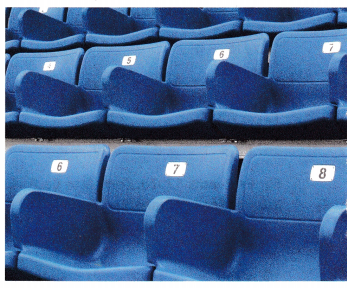
Question 33.

Answer:
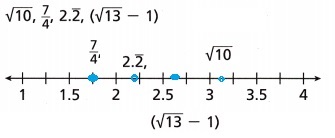 ,
,
Explanation:
All the fractions are converted in to decimals for pointing on the number line as shown below.
\(\sqrt{10}\) = 3.16, \(\frac{7}{4}\) = 1.75, 2.2 = 2.2, \(\sqrt{13}\) – 1 = 3.60 – 1 = 2.6.
Question 34.
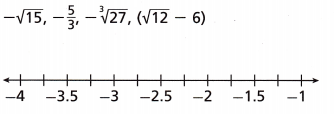
Answer:
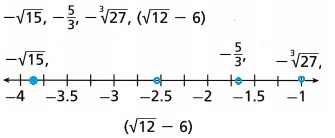
Explanation:
– \(\sqrt{15}\) = – 3.87, –\(\frac{5}{3}\) = -1.66, –\(\sqrt[3]{27}\) + 2 =- 3 + 2 = -1, \(\sqrt{12}\) – 6 = 3.46 – 6 = – 2.53.
Question 35.

Answer:

Explanation:
\(\sqrt{24}\) – 5 = 4.89 – 5 = -0.10, \(\sqrt{48}\) – 8 = 6.92 – 8 = -1.07,
\(\sqrt{60}\) – 5 = 7.74 -5 = 2.74, \(\sqrt{17}\) = 4.123.
For Problems 36-37, order the expressions from greatest to least.
Question 36.
\(\sqrt{27}, \frac{17}{6}, \sqrt[3]{70}, \pi, 1.8\)
Answer:
\( \sqrt{27}, \sqrt[3]{70}, \pi, \frac{17}{6}, 1.8 \),
Explanation:
Convert in to decimal form \(\sqrt{27}, \frac{17}{6}, \sqrt[3]{70}, \pi, 1.8\),
\(\sqrt{27}\) = 5.129, \(\frac{17}{6}\) = 2.83, \(\sqrt[3]{70}\) = 4.12,
pi = \(\sqrt[22]{7}\) = 3.142, 1.8 \( \sqrt{27}, \sqrt[3]{70}, \pi, \frac{17}{6}, 1.8 \).
Question 37.
\(\frac{2}{3}, \sqrt{2}, \frac{2}{9},(\sqrt{3}-1), \frac{10}{9}\)
Answer:
\( \sqrt{2}, \frac{10}{9},(\sqrt{3}-1), \frac{2}{3}, \frac{2}{9} \),
Explanation:
\(\frac{2}{3}, \sqrt{2}, \frac{2}{9},(\sqrt{3}-1), \frac{10}{9}\), \(\frac{2}{3}\) = 0.66,
\(\sqrt{2}\) =1.414, \(\frac{2}{9}\) = 0.22, \(\sqrt{3}\) – 1 =1.73 – 1= 0.73,
\(\frac{10}{9}\) = 1.11, 1.414, 1.11, 0.73, 0.66, 0.22, \( \sqrt{2}, \frac{10}{9},(\sqrt{3}-1), \frac{2}{3}, \frac{2}{9} \).
For Problems 38-39, order the expressions from least to greatest.
Question 38.
\(0.\overline{7},2 \sqrt{3},(\sqrt{32}-8),(-2+\sqrt{19}),\left(4-\frac{21}{4}\right)\)
Answer:
\((\sqrt{32}-8), \left(4-\frac{21}{4}\right), 0.\overline{7},(-2+\sqrt{19}), 2 \sqrt{3}\),
Explanation:
\(0.\overline{7},2 \sqrt{3},(\sqrt{32}-8),(-2+\sqrt{19}),\left(4-\frac{21}{4}\right)\),
\(0.\overline{7}\) =0.7, \(2 \sqrt{3}\) = 2 x 1.732 = 3.46,
\(\sqrt{32}-8\) = 5.65 – 8 = -2.34, \(-2+\sqrt{19}\) = – 2+ 4.35 = 2.35,
\(\left(4-\frac{21}{4}\right)\) = 4 – 5.25 = -1.25, -2.34, -1.25, 0.7, 2.35, 3.46,
\((\sqrt{32}-8), \left(4-\frac{21}{4}\right), 0.\overline{7},(-2+\sqrt{19}), 2 \sqrt{3}\).
Question 39.
\(-\frac{12}{5},(-6+\sqrt{30}),(\sqrt{15}-7),\left(3-\frac{30}{7}\right),-3 \sqrt{2}\)
Answer:
\((-6+\sqrt{30}), \left(3-\frac{30}{7}\right), -\frac{12}{5}, (\sqrt{15}-7), -3 \sqrt{2} \),
Explanation:
\(-\frac{12}{5}\) = -2.4, \((-6+\sqrt{30})\) = -6 + 5.47 = -0.53,
\((\sqrt{15}-7)\) = 3.87 – 7= -3.13, \(\left(3-\frac{30}{7}\right)\) = 3 – 4.28 = -1.28,
\(-3 \sqrt{2}\) = -3 x 1.414 =- 4.242, -0.53 , -1.28 , -2.4 , -3.13, – 4.242,
\((-6+\sqrt{30}), \left(3-\frac{30}{7}\right), -\frac{12}{5}, (\sqrt{15}-7), -3 \sqrt{2} \).
Question 40.
Which number is the best approximation for π2: 9, 9.3, 9.6, or 9.9?
Answer:
9.9 number is the best approximation for π2,
Explanation:
π2: 9, 9.3, 9.6, or 9.9,
π2 = \(\frac{22}{7}\)2 = 3.1422 =9.87 number is the best approximation for π2: is 9.9.
Question 41.
Which number is the best approximation for \(\frac{\pi}{3}\) : 1, 1.03, 1.05, or 1.07?
Answer:
1.05 number is the best approximation for \(\frac{\pi}{3}\) : \(\frac{22}{7 x 3}\),
Explanation:
Number is the best approximation for \(\frac{\pi}{3}\) : \(\frac{22}{7 x 3}\) = 1.047,
Number is the best approximation for \(\frac{\pi}{3}\) : \(\frac{22}{7 x 3}\) = 1.05.
Lesson 10.3 More Practice/Homework
Question 1.
Attend to Precision Through calculations, Jack and Kelsey estimated the diameter of the fountain in the park. If the actual length is 15 feet which student’s estimate is more accurate? Explain your reasoning.
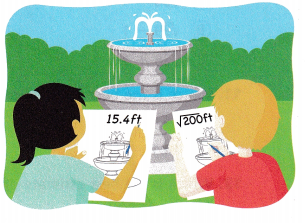
Answer:
Jack estimated the diameter of the fountain in the park as 15.4 ft,
Explanation:
Jack and Kelsey estimated the diameter of the fountain in the park
15.4 ft and \(\sqrt{200}\) ft,
15.4 and 14.15,
the actual length is 15 feet,
Jack estimated the diameter of the fountain in the park as 15.4 ft.
Question 2.
Complete the inequality with consecutive integers.
____________ < \(\sqrt{357}\) < ____________
Answer:
18 < \(\sqrt{357}\) < 19,
Explanation:
\(\sqrt{357}\) = 18.89, 18 < \(\sqrt{357}\) < 19.
Question 3.
Math on the Spot Compare the expressions. Write <, >, or =.
\(\sqrt{6}\) + 3 ![]() 6 + \(\sqrt{3}\)
6 + \(\sqrt{3}\)
Answer:
\(\sqrt{6}\) + 3 ![]() 6 + \(\sqrt{3}\),
6 + \(\sqrt{3}\),
Explanation:
\(\sqrt{6}\) + 3 ![]() 6 + \(\sqrt{3}\), 2.44 + 3
6 + \(\sqrt{3}\), 2.44 + 3 ![]() 6 + 1.73, 5.44
6 + 1.73, 5.44 ![]() 7.73.
7.73.
Question 4.
Estimate \(\sqrt{74}\) and \(\sqrt[3]{74}\) to the nearest tenth.
Answer:
\(\sqrt{74}\) to the nearest tenth =8.60, \([latex]\sqrt[3]{74}\) to the nearest tenth = 4.20,
Explanation:
\(\sqrt{74}\) = 8.60, \(\sqrt[3]{74}\) = 4.19, \(\sqrt{74}\) to the nearest tenth =8.60, \([latex]\sqrt[3]{74}\) to the nearest tenth = 4.20.
Question 5.
Open-Ended Identify two rational numbers and one irrational number between \(\sqrt{2}\) and \(\sqrt{3}\). Show how you know they are in this range.
Answer:
Explanation:
One irrational number between \(\sqrt{2}\) and \(\sqrt{3}\), \(\sqrt{2}\) < (\(\sqrt{2}\) +\(\sqrt{3}\) )/2 < \(\sqrt{3}\), two rational numbers between \(\sqrt{2}\) and \(\sqrt{3}\).
We know that \(\sqrt{2}\) = 1.414, \(\sqrt{3}\) = 1.732,
As \(\sqrt{2}\) < \(\sqrt{3}\), Hence
For Problems 6-7, plot the expressions on a number line.
Question 6.

Answer:

Explanation:
As \(\frac{17}\) = 4.123, \(\frac{22}{7 x 2}\) = 1.57, \(\frac{22}{7}\) = 3.142,
\(\frac{11}{4}\) = 2.75, 1.57, 2.75, 3.142, 4.123.
Question 7.

Answer:

Explanation:
As \(\frac{15}\) = 3.87, \(\sqrt{22}\) – 6 = 4.69 – 6 = -1.30,
\(\frac{16}{5}\) = 3.2, -5 + \(\frac{25}\) = -5 + 5 = 0.
Question 8.
Order the expressions from least to greatest.
\(\sqrt{31}, \frac{29}{9},(\sqrt{24}+2), \sqrt[3]{90}\) _____________
Answer:
\( \frac{29}{9}, \sqrt[3]{90}, \sqrt{31}, (\sqrt{24}+2)\),
Explanation:
As \(\frac{31}\) = 5.56, \( \frac{29}{9}\) = 3.22,
\((\sqrt{24}+2)\) = 4.89 + 2 = 6.89, \( \sqrt[3]{90}\) = 4.48,
\( \frac{29}{9}, \sqrt[3]{90}, \sqrt{31}, (\sqrt{24}+2)\).
Question 9.
Order the expressions from greatest to least.
\((\sqrt[3]{99}-5),(-\sqrt{45}+9),(\sqrt{71}-8), \frac{12}{7},-\frac{8}{5}\) _______________
Answer:
\((-\sqrt{45}+9) ,\frac{12}{7}, (\sqrt{71}-8), (\sqrt[3]{99}-5), -\frac{8}{5}, \),
Explanation:
\((\sqrt[3]{99}-5)\) = 4.62 – 5 = -0.37, \((-\sqrt{45}+9)\) =-6.70 + 9 = 2.29 = 2.3,
\((\sqrt{71}-8)\) = 8.42 – 8 = 0.42, \( \frac{12}{7}\) = 1.71,
\( -\frac{8}{5}\) =-1.6, -1.6, -0.37, 0.42, 1.71, 2.3,
\((-\sqrt{45}+9) ,\frac{12}{7}, (\sqrt{71}-8), (\sqrt[3]{99}-5), -\frac{8}{5}, \).
Test Prep
Question 10.
Which numbers make the inequality true? Select all that apply.
7 < ![]() < 8
< 8
(A) \(\sqrt{56}\)
(B) \(\sqrt{99}\) – 1
(C) \(\sqrt{38}\) + 1
(D) 3\(\sqrt{3}\) + 2
(E) 2\(\sqrt{2}\) + 3
Answer:
(A) \(\sqrt{56}\), (C) \(\sqrt{38}\) + 1, (D) 3\(\sqrt{3}\) + 2,
Explanation:
\(\sqrt{56}\) = 7.48, 7 < 7.48 < 8, \(\sqrt{38}\) + 1 = 6.16 + 1 = 7.16
7 < 7.16 < 8, 3\(\sqrt{3}[/latex.] + 2 = 3 x 1.73 = 5.19 +2 = 7.19, 7 < 7.19 < 8
Question 11.
Which is the best estimate of [latex]\sqrt{200}\)?
(A) 14.0
(B) 14.1
(C) 14.2
(D) 14.3
Answer:
Option (B),
Explanation:
Estimate of \(\sqrt{200}\) as 14.1 x 14.1 = 198.81.
Question 12.
Which is the best estimate of \(\sqrt[3]{84}\)?
(A) 4.38
(B) 4.39
(C) 4.40
(D) 4.41
Answer:
Option (A),
Explanation:
\(\sqrt[3]{84}\) = 4.38, \(\sqrt[3]{4.38 x 4.38 x 4.38}\) = 4.38.
Question 13.
Order the numerical expressions from least to greatest.
![]()
Answer:
![]() ,
,
Explanation:
As ![]() ,
,
\( – \frac{52}{5}}\) = -10.4,\(– \sqrt{130}\) = -11.4,
-3 – \(\sqrt{47}\) = -3 – 6.85 = – 9.85,
-11.4, -10.4, -9.85,
![]() .
.
Spiral Review
Question 14.
Would the number of hours traveled and the remaining distance to a destination likely have a strong negative or a strong positive association? Why?
Answer:
A strong positive association,
Explanation:
The number of hours traveled and the remaining distance to a destination likely have a strong positive, as he has to reach destination.
Question 15.
Does your music preference influence your choices for pet ownership? Keisha conducted a study of 41 students at her middle school. The results are displayed in the table to the right. Compare relative frequencies to determine whether there is a strong association between music choices and owning pets.
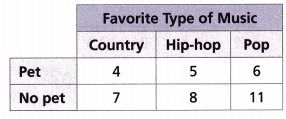
Answer:
x = 2x,
Explanation:
Keisha conducted a study of 41 students at her middle school.
pet x students like 2x music Pet 4 and Hip – hop music 2x, like x = 2x, 4 = 8.
Question 16.
Solve the equation 5x – 7 = 2(x + 8).
Answer:
x = 23/3,
Explanation:
Given to solve 5x – 7 = 2(x + 8), 5x – 7 = 2x + 16, 5x – 2x = 16 + 7, 3x = 23, x = 23/3.